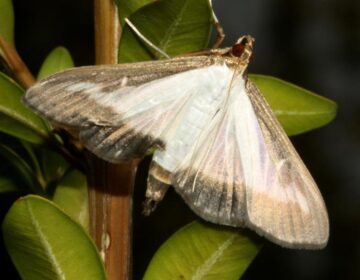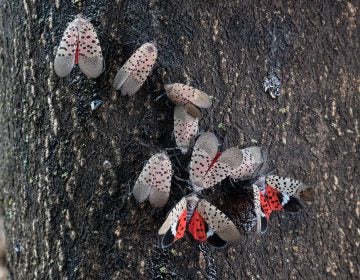Penn State researchers still need the public’s help to fight the spotted lanternfly, but a new tracking technique can help target emerging infestations
Scientists and the public are working to limit the spread of this harmful pest.

This Sept. 19, 2019, file photo, shows a spotted lanternfly at a vineyard in Kutztown, Pa. (Matt Rourke/AP Photo)
This story originally appeared on StateImpact Pennsylvania.
Penn State scientists have found new ways to track the spotted lanternfly and slow the spread of the plant damaging insect.
A new checklist can help Pennsylvanians identify the many places where the pest lays eggs. In addition, researchers have developed a technique for tracking where the insects go throughout their lifetimes.
Spotted lanternfly feed on, and eventually kill, grapevines and trees. According to Heather Leach, Extension Associate for Penn State, “the biggest impact today has been to vineyards. Spotted lanternfly really love to feed on grapes and we’re seeing yield losses and even vine deaths.”
According to Leach, the checklist and other outreach efforts are an important temporary measure for slowing the extent of the insect’s range.
“The whole goal right now is to slow that spread down and keep it as contained as possible. And so in the meantime, we can figure out what else we can do for spotted lanternfly management that’s more sustainable and long term,” said Leach.
Leach said many Pennsylvanians are eager to use the checklist because the insect damages trees in people’s yards and gardens. She said, “One of southeastern Pennsylvania’s favorite hobbies I would say is to go out and take vengeance on spotted lanternfly.”
Some conservation organizations like the Schuylkill Center for Environmental Education have said that it’s important to avoid other animals while fighting off these pests. For example, one popular method for catching the spotted lanternfly is wrapping tape around a tree trunk, but this method has killed bats and birds that get stuck on the sticky surface.
Dr. Mitzy Porras, an entomologist at Penn State, has found a less intrusive way to stop the spread of spotted lanternfly. She’s developed a method for tracking the insects throughout their lives using a technique called stable isotope enrichment.
With this technique, researchers can identify which insects have fed on target plants that they spray with a rare form of the nutrient nitrogen. According to Porras, this form of nitrogen doesn’t harm either the plant or the insect. Once the insect has eaten it, the nutrient spreads through their bodies like an invisible label. When researchers catch spotted lanternfly in different places, they can check to see if any of them have ever visited the target plant.
“Having a better understanding of the dispersal patterns of spotted lanternfly will help us to focus management strategies,” said Porras.
Her next steps are to use this technique to see how fast the spotted lanternfly moves across different types of environments, like forests as compared to agricultural fields.

Get daily updates from WHYY News!
WHYY is your source for fact-based, in-depth journalism and information. As a nonprofit organization, we rely on financial support from readers like you. Please give today.




